The Prototype
Introduction
In this project, a hybrid
solar vehicle prototype including a thermal engine, an electrical
motor/generator, a battery pack and photovoltaic panels will be developed
and tested. Design, assemblage and testing processes will be presented
on this web site, with particular care of didactic
sides. Design progresses may be followed through the roadmap
and photo
gallery. Within project deadline, the prototype will be tested and
presented to the media and information agencies.
The Choice
In the first stage of the project, different options
have been investigated to build the hybrid solar vehicle prototype. First
of all, it has been considered either to build a new vehicle
all over again or to develop the project starting from an existing
car. Although the first solution appeared to be interesting,
it was not feasible and consistent with time and budget limits. Moreover,
the second option offered a better chance to apply previous know how and
theoretic analyses. At that point, a vehicle typology had to be selected:
a kart or a car, with thermal
or electrical engine. Finally, an existing electric
vehicle was chosen as basic structure for prototype development.
The Structure
A “Series Hybrid Vehicle”
configuration seems to be the most suitable solution to match the framework
chosen. In this case, traction power is supplied only by the electrical
motor (EM/EG), which may operate also as generator during braking mode
(regenerative braking), adopting one of the electric vehicle energy recovery
strategies. Photovoltaic panels (PV) and the motor/generator system (ICE/EG)
either supply power to the electrical motor or charge the battery pack
(Battery), accordingly to control system strategies (Vehicle Management
Unit, VMU). Further details are available in On-line
simulator section.
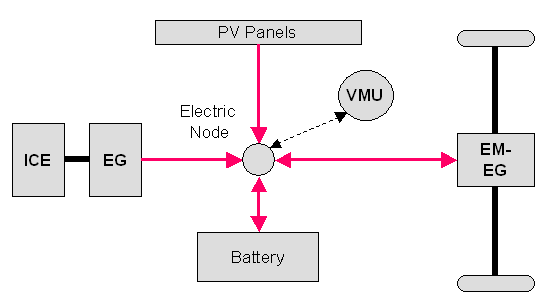
Series Solar Hybrid Vehicle Typology
The Electric Vehicle
A “Porter Glass Van” by Microvett has been
selected to develop the prototype. It is a light duty vehicle suited
for urban and protected areas, due to the lack of gas emissions and
noise. A “Porter Glass Van” has been provided to the research
group by Automobile Club Salerno (ACS), one of the project sponsors.
Porter
Glass Van donation to research group by ACS
A significant surface for photovoltaic panels housing
is available on the vehicle roof, while motor/generator and control
systems may be placed in the large trunk. The powertrain includes an
electric motor fed by batteries placed under the driver and passenger
compartment. The electric motor may be reached lifting driver seat.
| 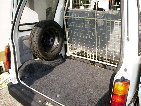
The Rear Bonnet |
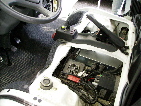
Electric Motor |
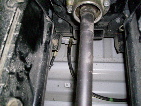
Transmission Shaft |
Electric vehicle technical data
Vehicle technical data such as typical sizes, overall
volumes, mass distribution, power provided by batteries and so on are
listed in the following tables.
Sizes |
Meters |
A |
3.560 |
B |
1.395 |
C |
1.870 |
D |
1.810 |
F |
0.540 |
G |
0.793 |
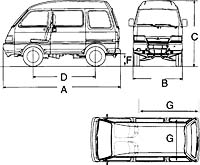
| Engine |
Direct Current Motor |
| Voltage
|
84 V |
| Nominal
power |
9 kW |
| Cooling
flow |
Air |
| Battery pack |
14 6V modules - 180 Ah Pb-Gel sealed, without maintenance |
| Battery charger |
On board - 3 kW - 230 V (standard industrial monophasic
plug) |
| Charging
time |
8 h |
| Rapid
charging |
5 kW - 380 V |
| Rapid
charging time |
2 h 45' @ 80% State of charge |
| Maximum
speed |
60 km/h |
| Range |
70 km in urban duty cicle |
| Transmission |
Direct to the rear axle |
| Steering
radius |
3,7 m |
| Seats |
4 |
Photovoltaic Panels
Referring to photovoltaic panels, different options have been investigated
and proper choices have been made:
- What kind of panels has to be used? In order to work
on a feasible solution, standard production silicon polycrystalline
panels have been selected, rather than high efficiency gallium arsenide
panels, capable to assure high performance but extremely expensive.
- A single panel or many smaller panels? The second
option has been followed to optimize single panel control as a function
of temperature and incoming solar radiation conditions, that may vary
on different panels.
- How may panels be mounted on the vehicle? May they
be integrated in the roof or an external support has to be provided?
First solution guarantees a better aerodynamics and an enjoyable look.
Second option assures higher flexibility during design stage and suggests
innovative ideas. For example, when vehicle is parked, panel orientation
may change following sun position. Finally, a travelling platform has
been chosen, taking into account that aerodynamic losses are negligible
due to vehicle low speed. Following the roof profile by means of two
articulations, an aluminium platform has been built by Saggese company
and donated to the research group.
| 
|
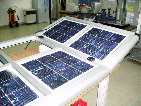
|

|
| |
The support for solar panels |
The solar panels are on the roof! |
The motor/generator system
…to be continued
|






